
|
|

July 25, 2008
The Big Trip 2007, part XII: The Studios of Boise, Idaho
It's become an annual tradition here at Tower Site of the Week - load up the tape decks and the DVD recorders and the cameras, line up a bunch of station tours, gather a few friends, and hit the road for as much as two weeks of in-depth exploration of the radio and TV environment in some scenic part of this great nation of ours. Then we come home and share it all with you, in pictures here on fybush.com and in audio (of legal IDs) over at our sister site, tophour.com.
"Big Trip 2007" covered parts of Utah, Wyoming, Idaho, Montana, Washington and Oregon over two weeks in late August and early September.
Days Eight, Nine and Ten - Thursday, August 31 - Sunday, September 2, 2007
While most of our Big Trip took us through smaller markets that could be easily seen in a day or less, there were two stops that required more attention - Salt Lake City, which we've already chronicled in multiple installments, and Boise, Idaho, where we spent the Labor Day weekend with our friends from the National Radio Club and the Worldwide TV-FM DX Association, who were holding their first-ever joint convention. Over the next three installments of Tower Site of the Week, we'll divert from a strict chronological recap of the trip and try to put this very interesting medium market in some kind of logical order.
Happily, the first stop on the trip, chronologically, is also a logical place to start our Tower Site visit to Boise: right around the corner from the convention hotel at the studios of KTVB-TV at 5407 W. Fairview, alongside the I-184 freeway on the west side of the city.

|
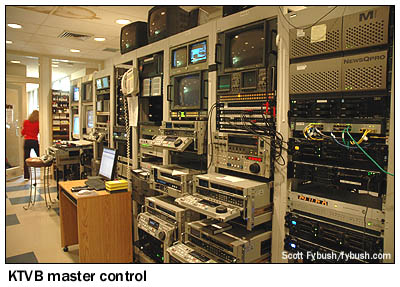
|
This was Boise's - and Idaho's - first surviving TV station, signing on in 1953 as KIDO-TV, sister station to KIDO (630). Philo T. Farnsworth himself was on hand for the station's debut broadcast. (Another station in nearby Nampa, KFXD-TV 6, signed on a month earlier, but survived for only a few weeks before shutting down; this was a small, small market back then, with just 35,000 people, and so a TV station was far from a sure profit-maker.)
Owner Georgia Davidson eventually sold off KIDO radio, changing the TV station's calls to KTVB, and in 1979 she sold the TV station to Seattle's King Broadcasting (another pioneering female-owned broadcaster, controlled by the legendary Bullitt sisters). Today, KTVB is owned by Belo, and it remains, as it was on Day One, an NBC affiliate.
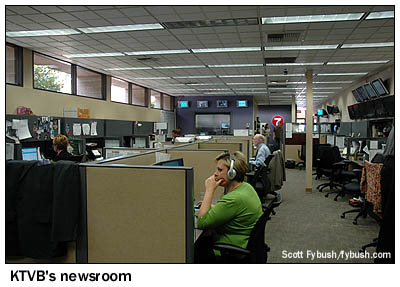
|
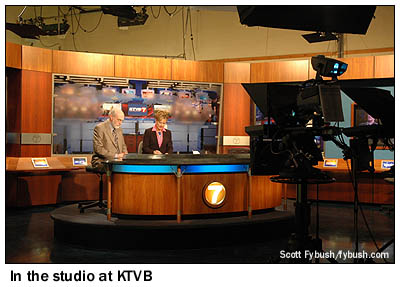
|
KTVB's studio building dates from the seventies, though of course it's been updated over the years, and the newscasts that originate here are still the top-rated in the market. Our tour group sits in on part of the noon news, where there's really only one story - it was just a day earlier that the news of Idaho Senator Larry Craig's arrest in that Minneapolis airport bathroom broke, and just a day later that Craig would announce his plans to resign - only to change his mind a couple of days later. An interesting time to visit, to be sure!
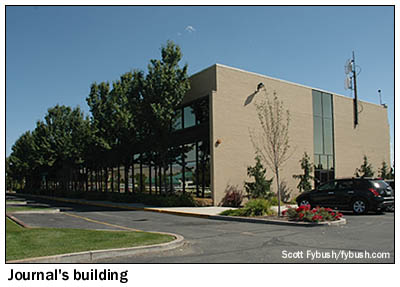
|
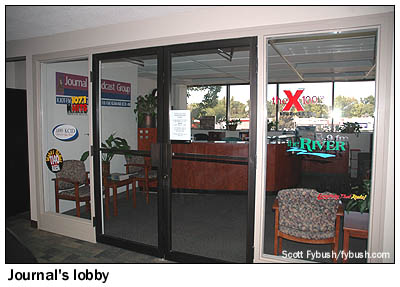
|
Right next door to KTVB, at 5257 W. Fairview, is the "Plaza Seven" office building (named for the TV station next door, we assume), and it's there, a day later, that engineer Rockwell "Rocky" Smith gives our group a tour of the Journal Broadcast Group radio stations that occupy most of the second floor. The cluster includes two AMs - oldies KGEM (1140 Boise) and standards KCID (1490 Caldwell) - and four FMs - AAA "River" KRVB (94.9 Nampa), modern rock "X" KQXR (100.3 Payette), classic rock "J105" KJOT (105.1 Boise) and classic hits "K-Hits" KTHI (107.1 Caldwell).
The FM studios are all arrayed in a long line along the back of the building, facing the freeway, each with a similar array of gear that includes a Harris console. The AMs are mostly satellite, and their nominal studios double as production rooms. Along a center corridor are more production rooms, a live-performance studio and control room, and Rocky's rack room.
(Want to learn some of his engineering tips? Visit his website at engineer-exchange.com!)
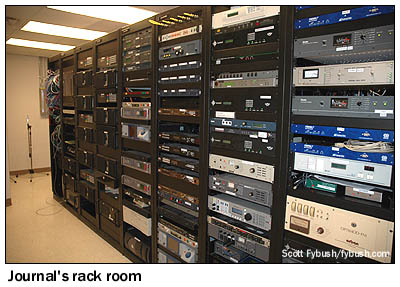
|
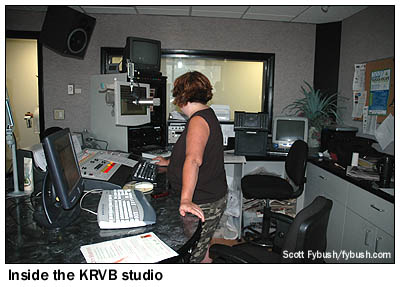
|
There are two other big radio clusters in town, and both are located near downtown Boise, which sits up against the mountains at the eastern end of the Treasure Valley. (As Boise has grown over the years, it's expanded almost entirely to the west, creating a line of nearly unbroken suburbs stretching 40 miles through Eagle, Nampa and Caldwell and almost to the Oregon border.)
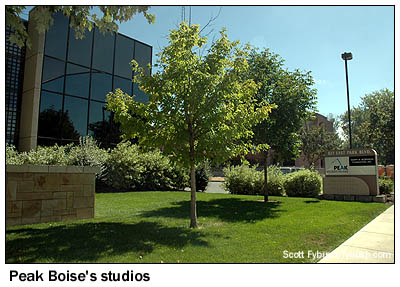
|
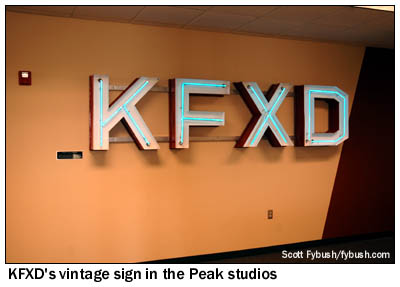
|
In an office park just south of downtown, not far from the Boise State University campus, we find the newish building that was home, until very recently, to Clear Channel's Boise stations. The stations are still there, but this was one of the markets Clear Channel spun off in 2007, and when we visited, the stations were in the hands of Peak Broadcasting. This cluster also includes four FMs - top 40 "Kiss" KSAS-FM (103.3 Caldwell), country "Wow" KAWO (104.3 Boise), hot AC "Mix" KCIX (105.9 Garden City) and AC "Lite FM" KXLT (107.9 Eagle) - and two AMs, KIDO (580 Nampa) and KFXD (630 Boise).
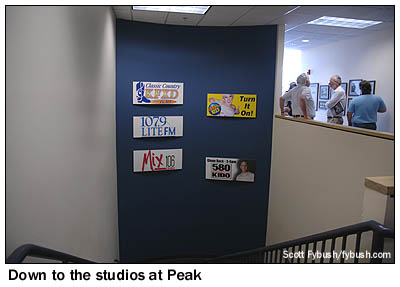 |
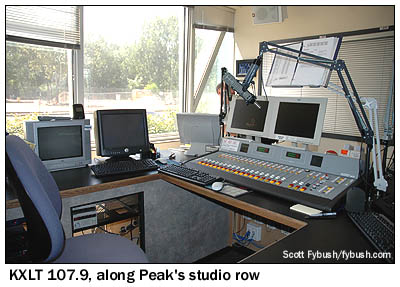
|
There's a story behind those call letters - each has a very long history in the market, but at the opposite spot on the dial. KFXD began in Logan, Utah in 1925, then moved to Jerome, Idaho before finally landing in Nampa in 1930. Initially on 1200/1230, it moved to 580 in 1947.
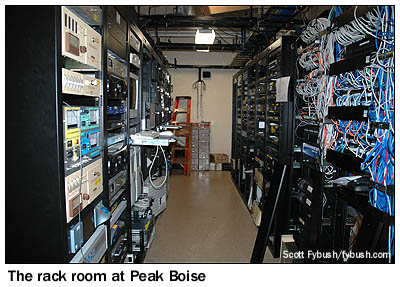 KIDO
traces its history back even further, to amateur station 7YA
in 1920, and to licensed station KFAU in 1922. By 1931 it was
on 1350, moving to 1380 with the 1941 NARBA shifts and then to
630 in 1951. In 2002, when KFXD and KIDO came under common ownership,
Clear Channel swapped the calls and programming between the two
frequencies in order to put the higher-rated KIDO on the better
580 facility. The move caused no end of confusion (at least to
radio historians), and many radio folks in the market still reflexively
say "KIDO" when speaking of the 630 facility and vice
versa.
KIDO
traces its history back even further, to amateur station 7YA
in 1920, and to licensed station KFAU in 1922. By 1931 it was
on 1350, moving to 1380 with the 1941 NARBA shifts and then to
630 in 1951. In 2002, when KFXD and KIDO came under common ownership,
Clear Channel swapped the calls and programming between the two
frequencies in order to put the higher-rated KIDO on the better
580 facility. The move caused no end of confusion (at least to
radio historians), and many radio folks in the market still reflexively
say "KIDO" when speaking of the 630 facility and vice
versa.
In any event, both stations' heritage is still celebrated in the building; the vintage KFXD sign that once illuminated the transmitter site now glows from a prominent spot on a second-floor wall, just across from the stairway that leads down from reception and sales to the studios on the ground floor. And the 80th anniversary of the KIDO call letters is being marked right now by the History of Idaho Broadcasting Foundation, which may end up working with the station on a book about its history.
The studios downstairs are all arrayed along a long hallway, with the FMs at one end and the two AMs at the other. The KXLT studio is typical of the cluster, with a Harris console and Prophet voicetracking running the show this midday.
KIDO's setup is a bit more complex - there's a control room that looks into a big corner talk studio, and an on-air newsroom that looks into both rooms.
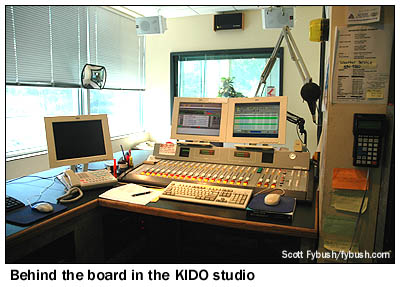 |
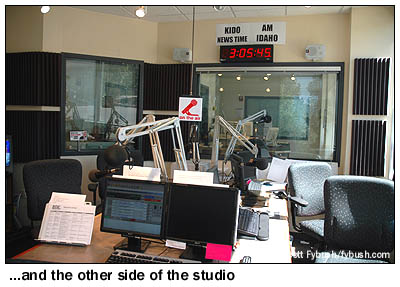
|
With thanks to engineer Lee Eichelberger, we move along to the third major cluster in Boise commercial radio. Citadel's stations are located on the north end of Boise's compact downtown, at 1419 W. Bannock Street, and engineer Bill Frahm has graciously agreed to spend part of his Saturday giving our clubs a tour of the building, which originally housed an architect's office.
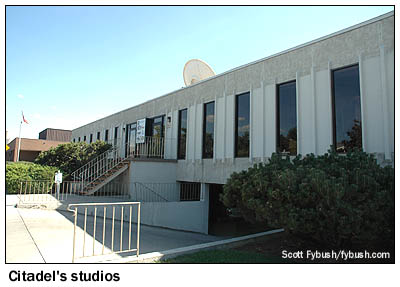 |
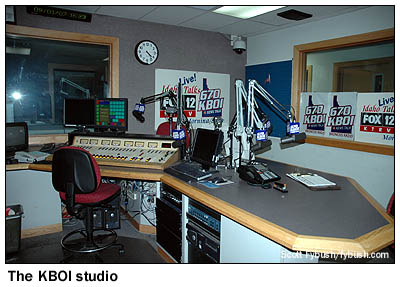
|
This, too, is a two-AM/four-FM cluster (is any other market so evenly matched?) - country "Kissin'" KIZN (92.3 Boise), top 40 "Magic" KZMG (93.1 New Plymouth), classic rock "Eagle" KKGL (96.9 Nampa) and country KQFC (97.9 Boise) on the FM side, and news-talk KBOI (670 Boise) and sports KTIK (1350 Nampa) on the AM side.
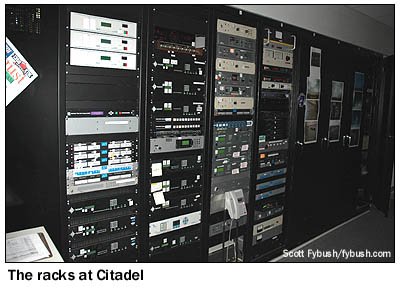 Instead
of a line of studios, this time around we find most of the studios
at the central core of the building, with several looking out
on the sales department's cubicle farm. KBOI's big talk studio
is equipped with cameras and lights, since its morning show is
simulcast on the market's Fox affiliate, KTRV (Channel 12); that
window above the console looks into the news booth, which adjoins
the newsroom next door.
Instead
of a line of studios, this time around we find most of the studios
at the central core of the building, with several looking out
on the sales department's cubicle farm. KBOI's big talk studio
is equipped with cameras and lights, since its morning show is
simulcast on the market's Fox affiliate, KTRV (Channel 12); that
window above the console looks into the news booth, which adjoins
the newsroom next door.
Unlike Peak and Journal, which park their racks behind locked doors, the Citadel "rack room" is really part of a hallway at the back of the studio core.
The engineers here - Bill and Randall Rocks, who, in good "small-radio-world" fashion, had recently come to Boise from Yellowstone Public Radio in Montana, where we'd met his successor a week earlier - believe in sharing as much engineering with their airstaff as they can, so there are pictures of the transmitter sites out here, and a neat graphical remote control that tracks the status of all three sites. (We'll see the two AM facilities in next week's installment and the combined FM facility, up at Deer Point, in two weeks.)
The only studios outside the central core are at this end of the building - KKGL is next door to engineering, while KTIK is all the way at the back corner of the building, where it has a nice big room to originate its local afternoon sports show.
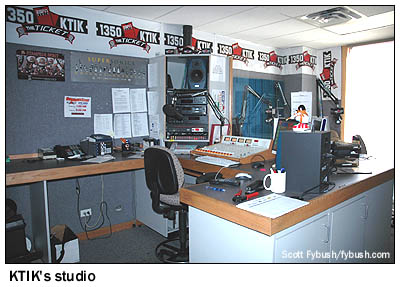 |
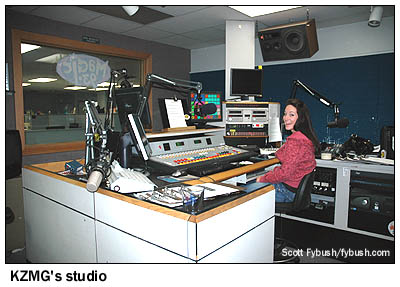
|
With thanks to Bill (we'll meet up with him again), we wrap up this installment by showing you a few more studios that we didn't get to tour during our too-short time in Boise:
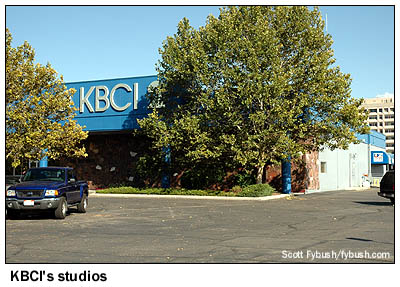 |
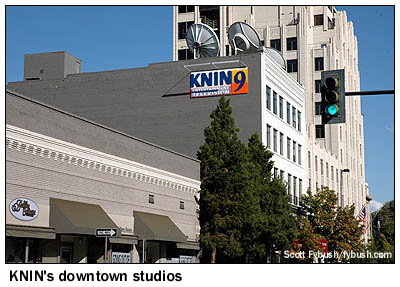
|
The former KBOI-TV, the second Boise TV station to survive, is now CBS affiliate KBCI (Channel 2), and its studios at 140 N. 16th Street are just a couple of blocks from Citadel, in a building shared with an auto-parts store. (Back in the days when KBOI radio and TV were together, they shared a much grander studio at 1007 W. Jefferson, a few blocks southeast of here; that building has been razed and is now a parking lot, sadly.)
The newest VHF station in town is CW affiliate KNIN (Channel 9), licensed to Caldwell but operating from an office building at 816 W. Bannock, just a few blocks from the state capitol building, which was undergoing massive renovations when we visited. Since our visit, Banks Broadcasting signed a deal to sell the station to Journal Broadcast Group, which will make it part of a duopoly with KIVI-TV, about which more in a moment.
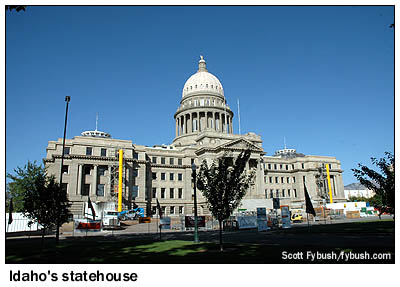 |
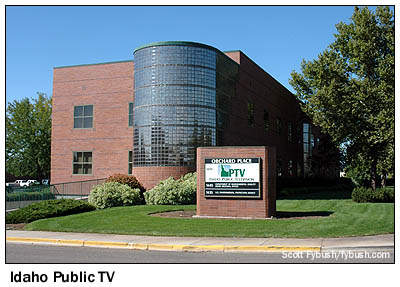
|
Back out in the suburbs, the Idaho Public TV studios are in an office building alongside I-184 at 1455 N. Orchard Street, just around the corner from the Journal radio stations and KTVB's studios.
It's a 20-minute drive west along I-184 and I-84 to Nampa, home of the other two TV signals in the market. Journal's KIVI-TV (Channel 6) is the ABC affiliate in the market; it signed on in 1974, taking the channel that had been briefly occupied two decades earlier by the short-lived KFXD-TV, and a recent infusion of cash by Journal has lifted it into a solid second place in the market behind KTVB. Its partnership with the Journal radio stations doesn't hurt, either; there's frequent on-air cross-promotion of the TV station on all the radio stations. (Which, yes, makes it a little ironic that the radio stations are housed next door to the competition, KTVB!)
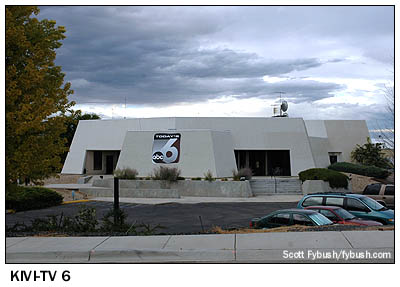 |
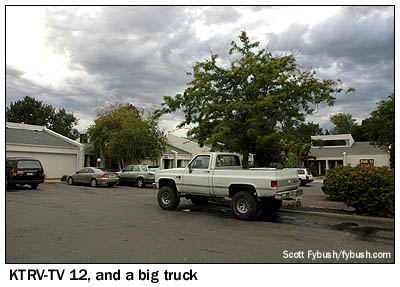
|
The KIVI studios are easily visible off the north side of I-84, though they actually sit on a frontage road at 1866 E. Chisholm Drive. One exit to the west, we find the studios of Fox affiliate KTRV (Channel 12) where the 6th Street Extension meets Idaho 55, just south of the highway ramps.
Enough studios? Ready for some transmitters? Tune in next Friday, when we'll show you the many AM sites in the market. And in the meantime, stop by Tophour.com next Wednesday to hear the first of three installments of Boise IDs.
Tower Site Calendar 2008 is almost sold out! Visit the Fybush.com Store now and get your calendar now!
- Previous Site of the Week: Big Trip 2007 Part XI - Eastern Oregon to Boise
- Next Week: Big Trip 2007 Part XIII - The AM Towers of Boise
- Site of the Week INDEX!
- How can you help support Site of the Week? Click here!
- Submit your suggestions for a future Site of the Week!
